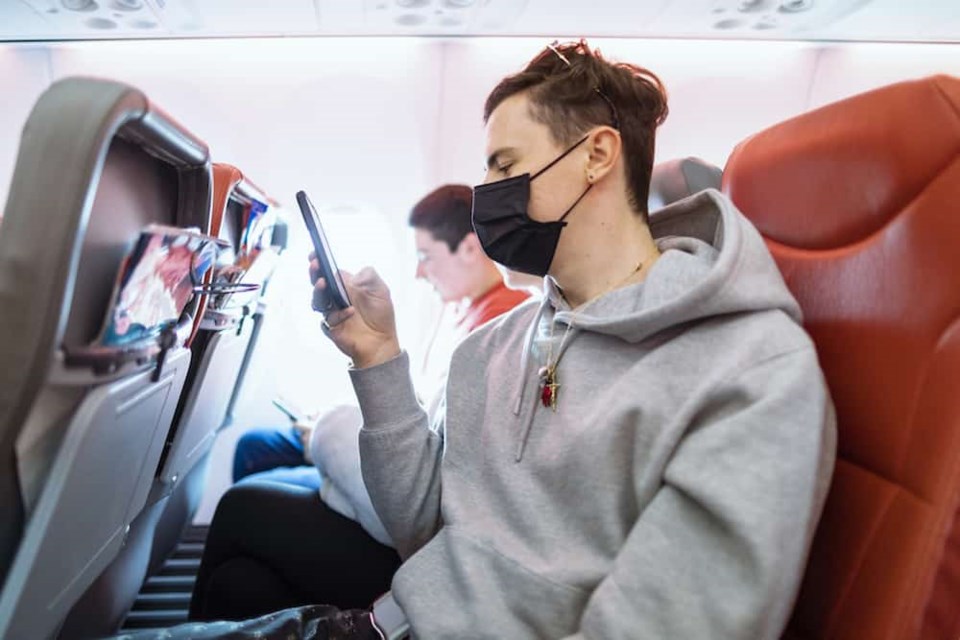The British Columbia Centre for Disease Control (BCCDC) has added even more B.C. flights to its list of public COVID-19 exposures.
The public health agency on Thursday, Nov. 19 warned passengers who travelled aboard the following 12 flights that they may have been exposed to the coronavirus responsible for the ongoing global pandemic.
- Nov 5, Air Canada 103, Toronto to Vancouver (Affected rows 42-45)
- Nov 5, Air Canada/Jazz 8183, Vancouver to Fort St. John (Affected rows 4-10)
- Nov 9, Air Canada 854, Vancouver to London (Affected rows 37-43)
- Nov 9, Swoop 207, Edmonton to Abbotsford (Affected rows 16-22)
- Nov 9, United Airlines 1641, Denver to Vancouver (Affected rows not reported)
- Nov 11, Alaska Airlines 3304, Seattle to Vancouver (Affected rows not reported)
- Nov 13, Air Canada 222, Vancouver to Calgary (Affected rows 22-28)
- Nov 13, Air India 185, Delhi to Vancouver (Affected rows not reported)
- Nov 14, Air Canada 561, San Francisco to Vancouver (Affected rows 12-17)
- Nov 16, Air Canada 209, Calgary to Vancouver (Affected rows 21-27)
- Nov 16, Air Canada 341, Ottawa to Vancouver (Affected rows 23-29)
- Nov 16, Air Canada/Jazz 8280, Vancouver to Prince Rupert (Affected rows 9-12)
One day prior, the BCCDC also flagged these 10 recent flights for potential COVID-19 exposure.
- Nov 6, Swoop 109, Hamilton to Abbotsford (Affected rows 21-27)
- Nov 7, Flair 8418, Toronto to Vancouver (Affected rows 10-16)
- Nov 9, WestJet 3342, Calgary to Kelowna (Affected rows 16-20)
- Nov 11, North Cariboo Air 1541, Terrace to Kelowna (Affected rows not reported)
- Nov 11, WestJet 711, Toronto to Vancouver (Affected rows 10-16)
- Nov 11, WestJet 3320, Vancouver to Kelowna (Affected rows 6-12)
- Nov 12, Air Canada 554, Vancouver to Los Angeles (Affected rows 21-27)
- Nov 13, Air Canada/Jazz 8571, Regina to Vancouver (Affected rows 18-24)
- Nov 15, Flair 8512, Vancouver to Toronto (Affected rows 2-8)
- Nov 16, Swoop 406, Toronto to Abbotsford (Affected rows 18-24)
The health agency also issued a correction to one previously-listed flight, which should have appeared as WestJet 195. The flight travelled from Calgary to Victoria on Nov. 14, while affected rows were not reported.
These updates come following numerous B.C. flights identified in recent days for carrying one or more individuals who have since tested positive for the virus, including these 7 B.C. flights Vancouver Is Awesome reported on Tuesday.
Thursday's additions also come just a few hours after B.C. provincial health officer Dr. Bonnie Henry implemented new orders instructing British Columbians to avoid any on-essential travel outside their home health region until Dec. 7.
Your flight has been identified for having COVID-19 on board. What next?
The BCCDC is encouraging travellers who recently returned to B.C. to check the public health agency's website for updates about flights identified for potential exposures. Passengers who flew aboard on a domestic flight flagged for carrying a COVID-19 case are in turn encouraged to self-monitor for symptoms for 14 days following their flight.
Any passengers who have travelled outside of Canada, meanwhile, are required to self-isolate and self-monitor for symptoms for 14 days upon their arrival.
Any returning travellers who develop symptoms following their arrival in Canada should get tested for COVID-19. Individuals who test positive are required to self-isolate for a minimum of 14 days from their arrival date, or 10 days after onset of symptoms, whichever is longer.
While self-monitoring for symptoms of the virus— which may include fever, cough, chills, sore throat, loss of sense of smell or taste and many more—individuals should take and record their temperature daily, and avoid taking fever-reducing medications like acetaminophen or ibuprofen if possible, for 14 days following their return to Canada or last known exposure to a confirmed COVID-19 case. The average normal body temperature taken orally is about 37°C, according to the BCCDC.
For more information about self-monitoring and self-isolation, head to the BCCDC's website.
Pandemic devastating travel industry
The country's two largest airlines ended their onboard seat distancing policies on July 1, raising health concerns amid a pandemic that has devastated the travel industry.
On social media, a few people ask why airlines are permitted to ignore physical distancing protocol while other businesses must adhere to them; others simply say they won't travel with airlines that don't have distancing policies in place.
As the coronavirus pandemic rages on, the government continues to discourage Canadians from any non-essential travel outside Canada until further notice. Officials have implemented a global travel advisory that effectively "overrides other risk levels ... with the exception of any risk levels for countries or regions where we advise to avoid all travel."
With files from The Canadian Press, Lindsay William-Ross and Elana Shepert



